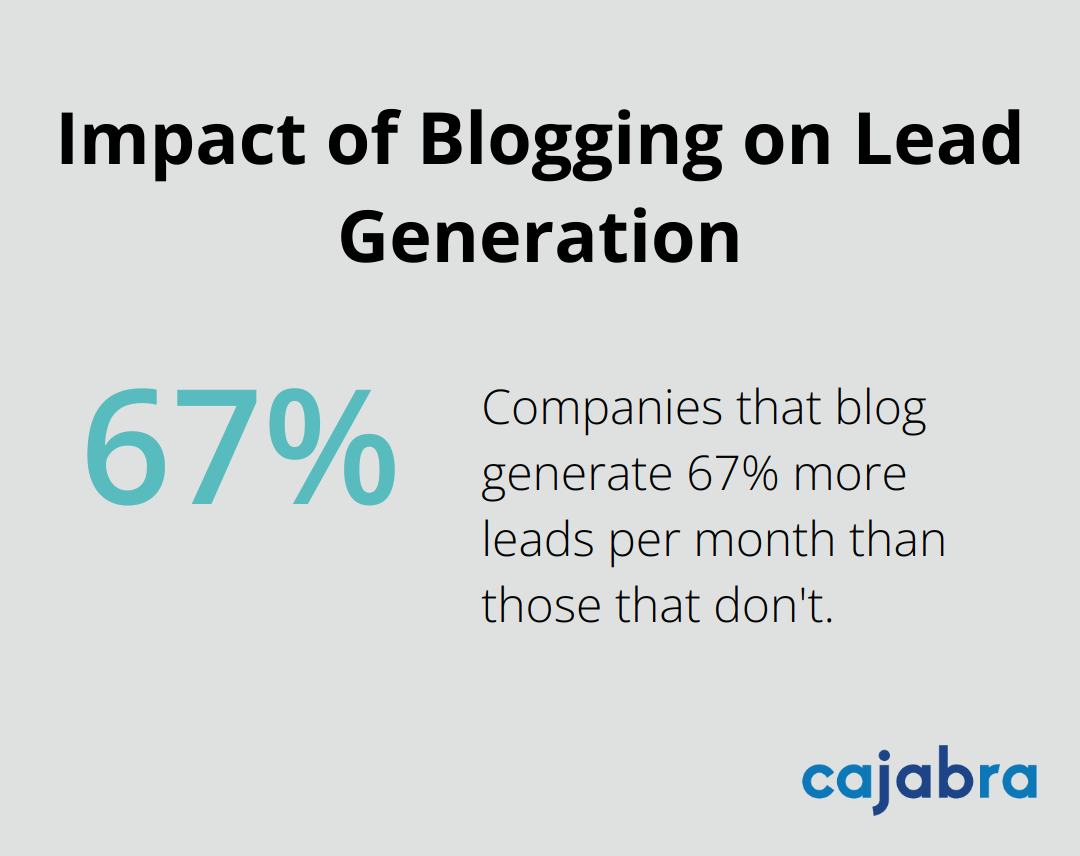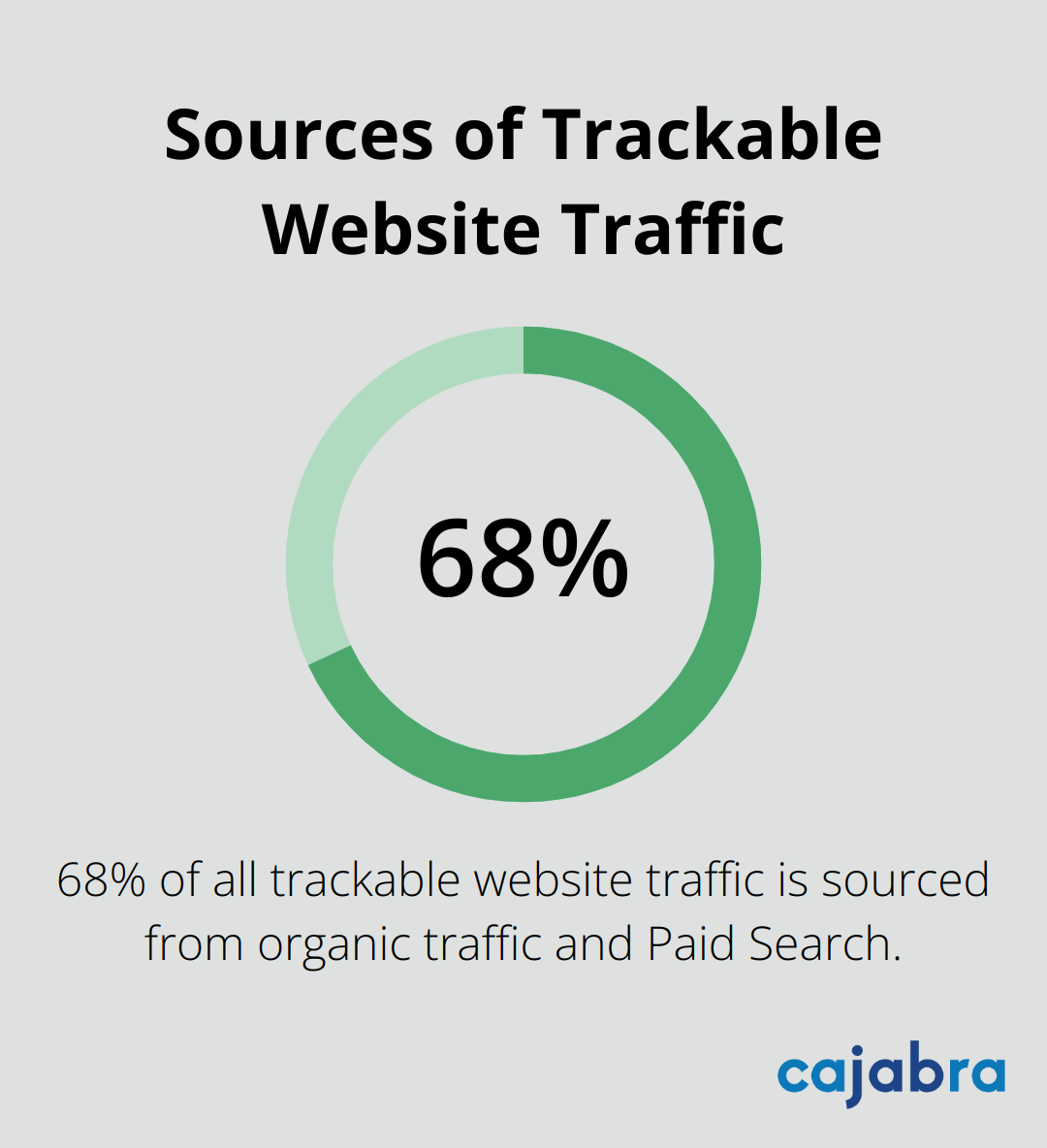
At Cajabra, LLC, we know that content marketing and lead generation are powerful tools for business growth.
In this post, we'll show you how to combine these strategies effectively.
You'll learn practical tactics to create content that attracts potential customers and converts them into leads.
Content marketing for lead generation is a strategic approach that uses valuable, relevant content to attract and engage potential customers, ultimately converting them into leads for your business. This method involves the creation and distribution of content that addresses the needs, interests, and pain points of your target audience.
Content marketing has become a cornerstone of effective lead generation strategies. According to the Content Marketing Institute, last year, 57% of B2B marketers cited creating the right content for the audience as a challenge, but this year, only 40% did. This approach goes beyond mere content creation; it focuses on crafting content that resonates with your audience and guides them through the sales funnel.
Different content types can drive lead generation, depending on your audience and goals. Here are some high-performing content types:

To harness the power of content marketing for lead generation, you must track its impact. Tools like Google Analytics help monitor metrics such as website traffic, time on page, and conversion rates. Data-driven content strategies can significantly boost lead generation efforts (especially in industries like accounting).
Effective content marketing for lead generation doesn't rely on hard selling. It provides value, builds trust, and guides potential customers towards your solutions. High-quality, targeted content attracts more qualified leads and sets the stage for long-term business growth.
Now that we've explored what content marketing for lead generation entails, let's move on to creating a robust content marketing strategy that will supercharge your lead generation efforts.
Start your strategy by setting specific, measurable goals. Instead of vague aspirations, target concrete outcomes. For example, set a goal to increase website traffic by 50% in six months or generate 100 new leads per quarter. These precise targets will guide your content creation and provide benchmarks for success measurement.
Develop detailed buyer personas based on demographic data, pain points, and preferences. For instance, if you target small business owners, consider their challenges with cash flow management or tax compliance. This insight will help you create content that addresses their specific needs and resonates with their concerns.
Develop a content calendar that aligns with your goals and audience needs. Include a mix of content types, such as blog posts, case studies, and webinars. For example, plan a series of blog posts on tax-saving strategies leading up to tax season, followed by a webinar on year-end financial planning.
Only 37% of B2B marketers have a documented content marketing strategy. This planning ensures consistency and helps maintain a steady flow of relevant content.
Research keywords relevant to your audience and industry. For accounting firms, this might include terms like "small business tax tips" or "financial planning for entrepreneurs." Use these keywords naturally in your content, meta descriptions, and headers.
68% of all trackable website traffic is sourced from organic traffic and Paid Search, vastly exceeding all other channels, including Display and Social Media. By optimizing your content, you increase your chances of being found by potential clients when they search for solutions you offer.

Your content needs to reach your audience. Utilize multiple channels for distribution, including social media, email newsletters, and industry forums. LinkedIn can be particularly effective for B2B content distribution in the accounting sector.
Tailor your content for each platform. A long-form article might work well on your blog, while shorter, punchier versions could be more effective on social media.
Now that you have a solid strategy in place, let's explore how to implement lead generation tactics within your content marketing efforts.
Lead magnets form the foundation of content-driven lead generation. These valuable content pieces persuade potential clients to share their contact information. Effective lead magnets for accounting firms include tax preparation checklists, financial planning guides, or industry-specific financial benchmarking reports.
To create a compelling lead magnet, solve a specific problem your target audience faces. For example, a guide on "10 Tax-Saving Strategies for Small Businesses" attracts potential clients. Deliver immediate value and showcase your expertise in your lead magnet.
Landing pages convert visitors into leads. A well-designed landing page boosts your conversion rates significantly. The average conversion rate across Google Ads is 4.40% on the search network and 0.57% on the display network.
To optimize your landing page:
Make your call-to-action (CTA) button stand out visually and use action-oriented language. Replace generic phrases like "Submit" with specific CTAs like "Get My Free Tax Guide" or "Start My Financial Assessment."
Email marketing nurtures leads and moves them through your sales funnel. This powerful tool drives an ROI of $44 for every $1 spent (a 4,400% return on investment).

Segment your email list based on factors like industry, company size, or specific interests. This allows you to tailor your content to each group's needs. Create an email sequence that introduces your services and demonstrates your value gradually.
Start with a welcome email that delivers the lead magnet. Follow up with a series of emails sharing tax tips, industry insights, and case studies. Include occasional soft sells, but prioritize providing value.
Social media amplifies your content marketing efforts. It helps you reach a wider audience and engage with potential leads. LinkedIn proves particularly effective for B2B marketing, with 80% of B2B leads originating from this platform.
Share snippets of your content on social media platforms, linking back to the full piece on your website. Use relevant hashtags to increase visibility. Engage with your followers by responding to comments and participating in industry discussions.
Consider using paid social media advertising to boost your reach. LinkedIn's targeting options allow you to reach decision-makers in specific industries or company sizes (ideal for accounting firms).
Implement analytics tools to track the performance of your content and lead generation efforts. Monitor metrics such as conversion rates, engagement levels, and lead quality. Use these insights to refine your strategy and improve your results over time.
Try A/B testing different elements of your content and landing pages to identify what resonates best with your audience. This data-driven approach ensures continuous improvement in your lead generation efforts.
Content marketing and lead generation form a powerful combination that can transform your business. You will attract, engage, and convert potential clients more efficiently when you create valuable, targeted content and implement strategic lead generation tactics. A clear strategy, SEO best practices, and effective lead magnets will increase your visibility and reach your target market.
Social media platforms, particularly LinkedIn for B2B marketing, will amplify your reach. Analytics tools will help you track performance and refine your approach continuously. This data-driven strategy ensures that your content marketing efforts consistently improve and deliver better results over time.
At Cajabra, we offer a specialized marketing service designed to help accountants move from overlooked to overbooked in 90 days. We handle all aspects of marketing, which allows you to focus on serving your clients. Start implementing these strategies today, and watch your business grow.



